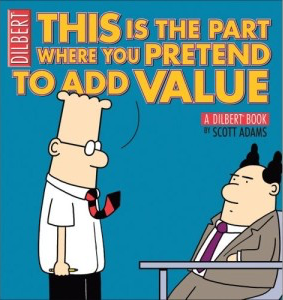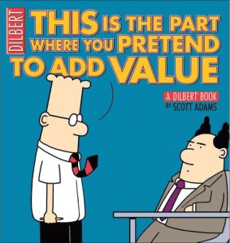Why it's time to STOP "Adding Value"
October 8, 2015

 It’s probably the most commonly proposed response to price pressures and commoditisation: if we’re not prepared to cut our prices, we had better add more value for the customer. It’s a reasonable objective, but the sad truth is that most so-called “value-added” strategies simply add cost and complexity without making the offering any more desirable to the customer. In fact, they often have the opposite effect.
It’s probably the most commonly proposed response to price pressures and commoditisation: if we’re not prepared to cut our prices, we had better add more value for the customer. It’s a reasonable objective, but the sad truth is that most so-called “value-added” strategies simply add cost and complexity without making the offering any more desirable to the customer. In fact, they often have the opposite effect.
It might be a good idea to start by defining exactly what we mean by value. For many product-focused organisations, it’s seen primarily in terms of adding incremental functionality without adding much or anything to the price quoted to the customer. But that’s not how the customer typically views it...
In fact, any attempt to associate value with functionality is almost certainly doomed unless that value is expressed in terms that are meaningful to the customer. And that’s really the crux of the matter: no vendor (and no sales person) can credibly define what “value” means - it can only be recognised by the customer.
Value is only in the eyes of the customer
That's why my preferred definition of value has nothing to do with functionality. Very simply put, value is that which the customer is prepared to pay for with their time and/or (preferably) their money. Value is an exchange between two parties - it is never an intrinsic feature of a product or solution.
So the only way of truly adding value is to make our customer’s lives easier, more productive or more profitable. From this perspective, the greatest value often comes from simplifying rather than making things more complex. Simply loading or bundling unwanted features, services or capabilities into an offering reduces its true value, rather than increasing it.
It's all in the customer experience
It’s something that Apple understands almost uniquely well and it’s something they have mastered and refined over many years. When you compare the fine detail of product specs - let’s take the pixel rating of the camera as an example - Apple rarely comes out at the very top.
And when you compare features and functions generally, it’s not unusual for Apple’s competitors to boast a longer or apparently more impressive list. Where Apple distinguish themselves, time after time, is in the quality of the overall customer and user experience - and in how every element works together.
In the case of their irrelevant-feature-function-chasing competitors, the whole is (often far) less than the sum of the parts. But in organisations that truly understand customer value, the whole is (often far) larger than a simple addition of the sum of the parts might otherwise suggest.
Themes are far more powerful than lists
While competitors strive to have the longer or stronger list of raw features, Apple focuses instead on resonant, compelling and consistent themes that talk directly to the actual practical experience of using what you’ve purchased. And it’s not just about the user experience. I have never been let down - in terms of the buying or the delivery experience - when buying from Apple. I cannot think of another technology manufacturer or retailer I can say the same about.
So when organisations come under pressure from competitive pricing or the threat of commoditisation, the traditional knee-jerk reaction that they have got to "add value" by including more product functionality or bundling additional services is somewhat dysfunctional at best and (more typically) just a way of adding to their cost of goods or cost of sale without actually creating more customer value. In fact, in many cases, such strategies actually destroy customer value and prevent sales. This is as true for B2B sales as it is for B2C.
The buyer and user experience
So what's the answer? To better understand what your ideal customers truly value. To understand how you can make both the buying experience and the user experience more attractive. To ensure that the customer solves the problem they came to you with in the first place, and get the value they were looking for, and preferably exceed it. In other words to shorten and simplify the customer's time-to-true-value.
But please don’t react by adding meaningless “value” that only serves to make your customers lives more complicated, and forces them to buy things they don’t really need or will never use. Even if you con them into buying from you in the first place, they won’t thank you for it, they probably won’t buy again, and they certainly won’t recommend you to their colleagues and friends.
When it comes to creating true customer value, less is often more, and an effortless buyer and user experience something that is truly and deeply appreciated - in large part because of how rarely it happens.


Comments